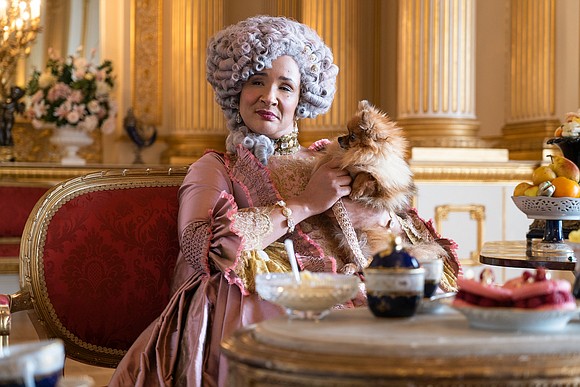'Bridgerton's' Queen Charlotte latest to stir Black debate
CNN/Stylemagazine.com Newswire | 12/30/2020, 3:28 p.m.
By Lisa Respers France, CNN
(CNN) -- Leave it to Shonda Rhimes to give us a Black queen.
Rhimes' production company, Shondaland, is behind the new hit period Netflix drama, "Bridgerton" which includes Black and White members of early 19th century British high society.
The series was created by its showrunner Chris Van Dusen and is based on a Regency novel by Julia Quinn. In the show, Britain's real-life Queen Charlotte is portrayed as a Black woman by actress Golda Rosheuvel.
Many have long believed that the queen, who was married to King George III and is an ancestor of the current Queen Elizabeth, had African ancestry based in part on the images of her.
Yet there are others who dispute that claim.
Quinn talked to The Times about the diverse casting of the show based on her book.
"Many historians believe she had some African background," she said. "It's a highly debated point and we can't DNA test her so I don't think there'll ever be a definitive answer."
Queen Charlotte is just one of many through history whose racial identity has been debated.
Here are a few others:
Ludwig van Beethoven
In September The Guardian's Philip Clark wrote about the belief that the famed composer was of mixed heritage.
The writer reported that the theory was floated in 1907 by British composer Samuel Coleridge-Taylor who was mixed and said he saw a resemblance between his features and that of the likenesses of Beethoven.
It's an idea which Clark says survived the years and was picked up by Black activists Stokely Carmichael and Malcolm X.
"Was Beethoven black? The evidence is scant and inconclusive," Clark wrote.
"The case rests on two possibilities: that Beethoven's Flemish ancestors married Spanish "blackamoors" of African descent, or that Beethoven's mother had an affair. But the truth Carmichael and Malcolm X sought was not scientific. "Beethoven was black" was a grand metaphor designed to unsettle and shake certainty."
J. Edgar Hoover
The first director of the Federal Bureau of Investigation was well known for the work he did to undermine the civil rights movement and its leaders.
In 2011 Barbara A. Reynolds wrote a piece for the Washington Post which examined speculation that Hoover was of mixed heritage and "passing" as a white man prior to his death in 1972.
The story quoted Millie McGhee, author of "Secrets Uncovered, J Edgar Hoover -- Passing For White?" an African American woman who recalled being told she was related to Hoover when she was growing up in McComb, Mississippi.
McGhee said her later research unearthed that they were indeed family.
"Because of Edgar's anti-black history, I am not proud of this lineage but history must be based on truth," she said.
Jacqueline Bouvier Kennedy Onassis
Was Jackie Kennedy the first Black first lady?
This theory seems to stem from research into her ancestry.
According to information from the New England Historical Society, she was descended from early New York settlers Anthony and Abraham van Salee -- who were believed to have been born to Dutch pirate Jan Janszoon and a mixed-race mistress of his.
The piece notes that "When First Lady Jackie Kennedy visited England in 1961, society photographer Cecil Beaton met her at a dinner party. In his journal he commented she had a "Negroid" appearance.
Some historians have also noted that her father, Wall Street stockbroker John Vernou Bouvier III, was called "Black Jack" which they attributed to his swarthy complexion.
Clark Gable
Gable was known as the tall, dark and handsome "King of Hollywood."
There has long been talk that he had both Black and Native American heritage, which no one has ever thoroughly documented.
But he was well known for his early championing of African American civil rights.
In 2005 actor Lennie Bluett told NPR's "Hearing Voices" about being an extra on the set of "Gone With the Wind" in Culver City, California, in 1938 when he alerted Gable to the fact that there were segregated portable bathrooms marked "White" and "Colored."
"He looked at me and he read the signs and he cussed like a sailor," Bluett recalled.
Gable, who was the star of the film, went to the director and the property master and demanded that the signs be removed or else the hundreds of Black extras on the set that day would walk off.
Bluett said the signs were removed.









